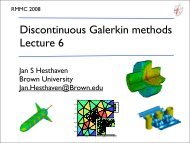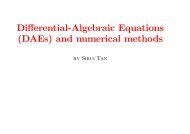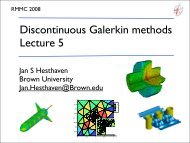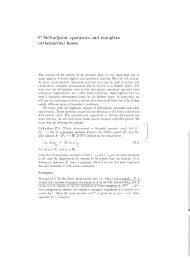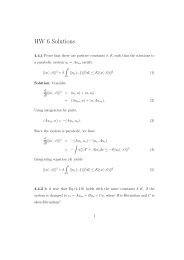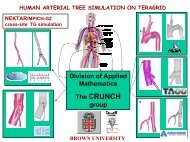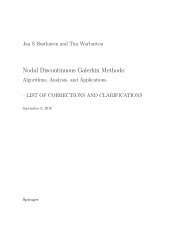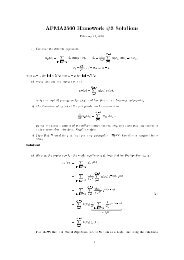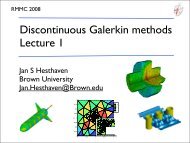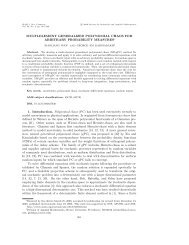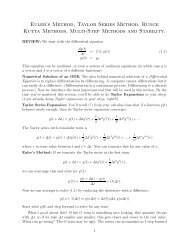Discontinuous Galerkin methods Lecture 3 - Brown University
Discontinuous Galerkin methods Lecture 3 - Brown University
Discontinuous Galerkin methods Lecture 3 - Brown University
Create successful ePaper yourself
Turn your PDF publications into a flip-book with our unique Google optimized e-Paper software.
determinant continues to increase in size with N, reflecting a well-behaved<br />
interpolation where ℓi(r) takes small values in between the nodes. For the<br />
Local approximation - an example<br />
equidistant nodes, the situation is entirely different.<br />
While the determinant has comparable values for small values of N, the<br />
determinant for the equidistant nodes begins to decay exponentially fast once<br />
N exceeds So does 16, caused it really by the matter? close to linear -- dependence consider of Vthe<br />
last columns<br />
a)<br />
c)<br />
1.00 −1.00 1.00 −1.00 1.00 −1.00 1.00<br />
1.00 −0.67 0.44 −0.30 0.20 −0.13 0.09<br />
1.00 −0.33 0.11 −0.04 0.01 −0.00 0.00<br />
1.00 0.00 0.00 0.00 0.00 0.00 0.00<br />
1.00 0.33 0.11 0.04 0.01 0.00 0.00<br />
1.00 0.67 0.44 0.30 0.20 0.13 0.09<br />
1.00 1.00 1.00 1.00 1.00 1.00 1.00<br />
0.71 −1.22 1.58 −1.87 2.12 −2.35 2.55<br />
0.71 −0.82 0.26 0.49 −0.91 0.72 −0.04<br />
0.71 −0.41 −0.53 0.76 0.03 −0.78 0.49<br />
0.71 0.00 −0.79 0.00 0.80 0.00 −0.80<br />
0.71 0.41 −0.53 −0.76 0.03 0.78 0.49<br />
0.71 0.82 0.26 −0.49 −0.91 −0.72 −0.04<br />
0.71 1.22 1.58 1.87 2.12 2.35 2.55<br />
b)<br />
d)<br />
1.00 −1.00 1.00 −1.00 1.00 −1.00 1.00<br />
1.00 −0.83 0.69 −0.57 0.48 −0.39 0.33<br />
1.00 −0.47 0.22 −0.10 0.05 −0.02 0.01<br />
1.00 0.00 0.00 0.00 0.00 0.00 0.00<br />
1.00 0.47 0.22 0.10 0.05 0.02 0.01<br />
1.00 0.83 0.69 0.57 0.48 0.39 0.33<br />
1.00 1.00 1.00 1.00 1.00 1.00 1.00<br />
0.71 −1.22 1.58 −1.87 2.12 −2.35 2.55<br />
0.71 −1.02 0.84 −0.35 −0.28 0.81 −1.06<br />
0.71 −0.57 −0.27 0.83 −0.50 −0.37 0.85<br />
0.71 0.00 −0.79 0.00 0.80 0.00 −0.80<br />
0.71 0.57 −0.27 −0.83 −0.50 0.37 0.85<br />
0.71 1.02 0.84 0.35 −0.29 −0.81 −1.06<br />
0.71 1.22 1.58 1.87 2.12 2.35 2.55<br />
Bad points Good points<br />
Fig. 3.1. Entries of V for N = 6 and different choices of the basis, ψn(r), and<br />
evaluation points, ξi. For (a) and (c) we use equidistant points and (b) and (d) are<br />
based on LGL points. Furthermore, (a) and (b) are based on V computed using a<br />
simple monomial basis, ψn(r) =r n−1 , while (c) and (d) are based on the orthonormal<br />
Bad<br />
basis<br />
Good<br />
basis



